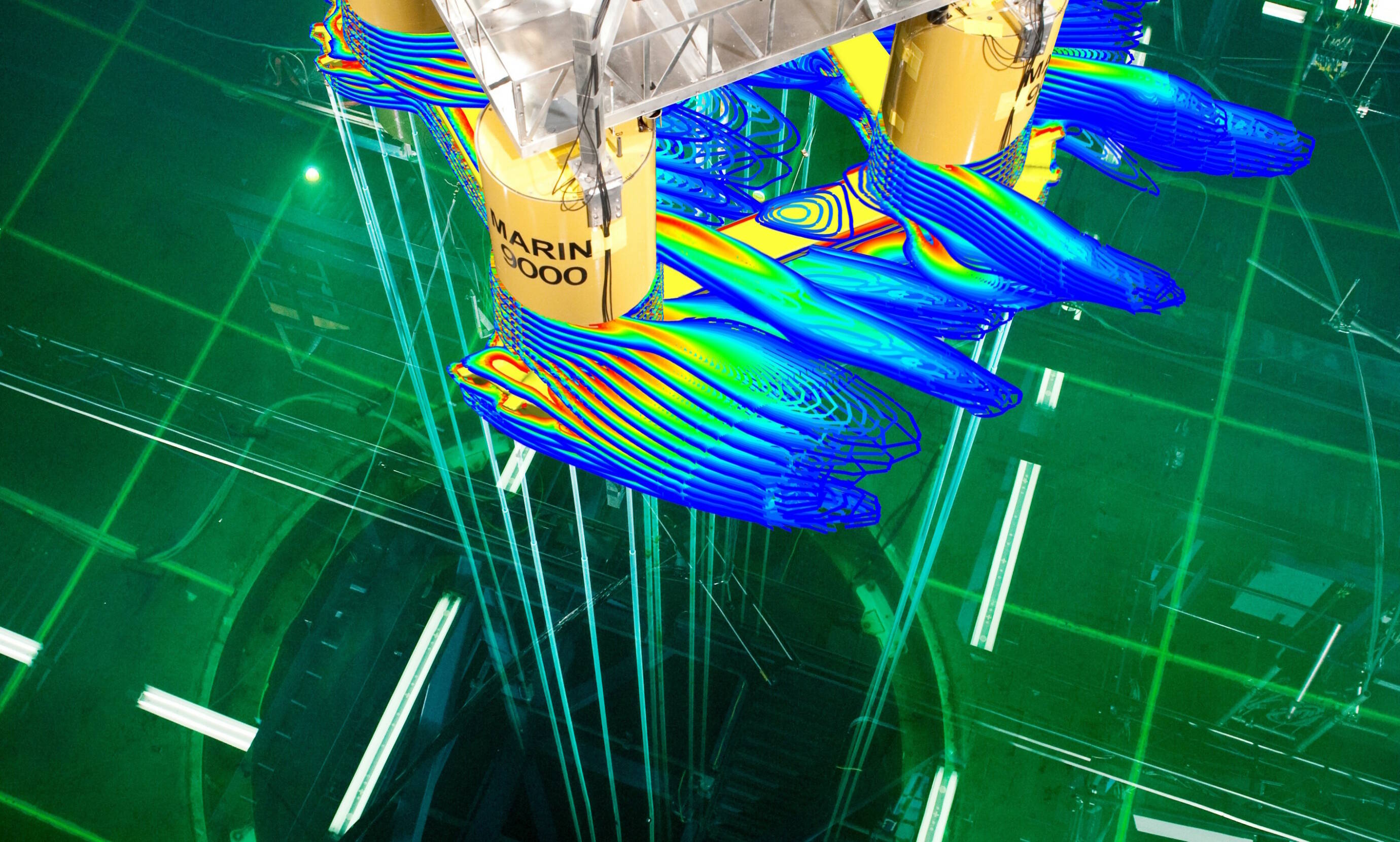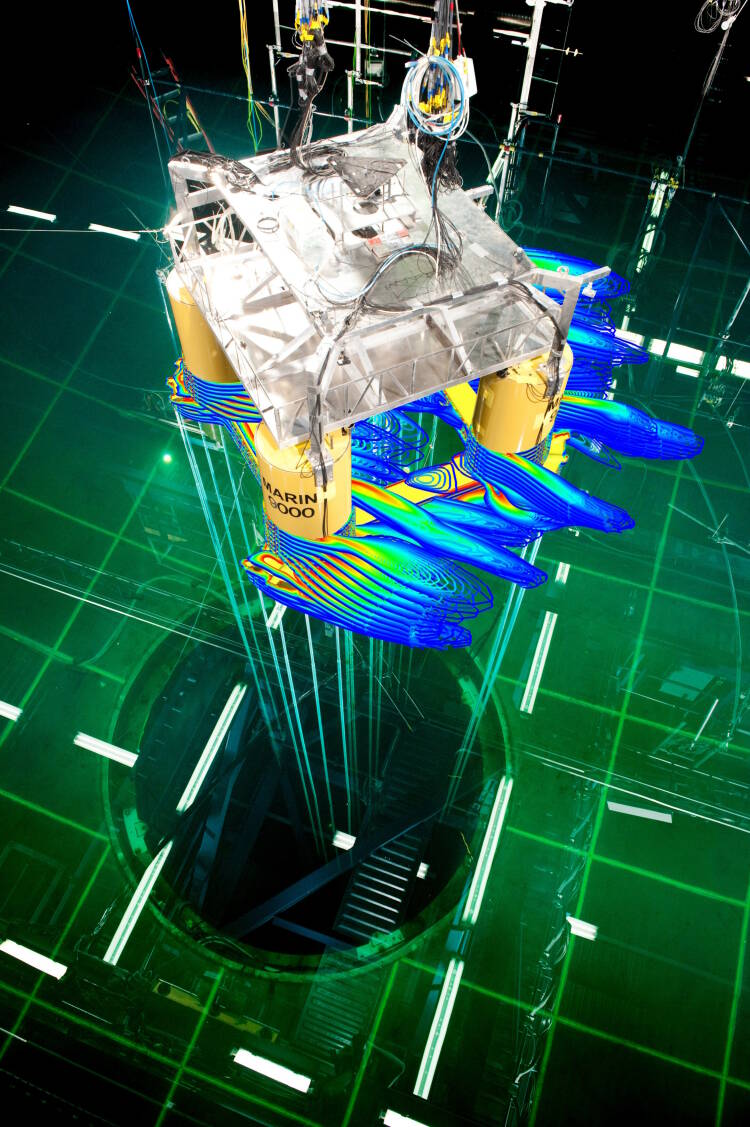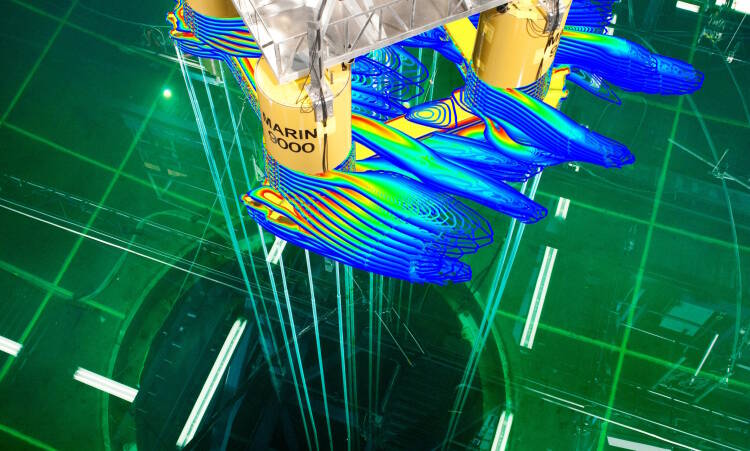News
Shallow water
EEXI
Wind propulsion
Turbulent breakthrough
CFD VIM
Floating Wind
Shortsea shipping
Cover
Create a MARIN account to stay updated

REFERENCES
With CFD simulations the VIM response of bare hull semi-submersible floaters can be accurately assessed when comparing to model test results, see [2] for a joint industry effort to provide a modelling practice for CFD calculations to predict VIM response.
These numerical simulations provide a complimentary means to model testing to investigate the VIM response of floating platforms. The advantage of CFD is that detailed flow and loading assessments can be carried out to gain better insight into the physical phenomena of this complex fluid-structure interaction problem. An example is provided in the following video.
Illustration of the flow field around the semi-submersible during VIM with the forces on the columns and pontoons illustrated by the black and red arrows, where the black arrow is for the force on an individual column or pontoon and the red arrow is for the columns combined and the pontoons combined. Also, the total lift and drag forces on the semi-submersible and the motions of the semi-submersible are shown in time traces with the red dot illustrating the instant of time shown on the left.
December 2023, no. 138




[1] Koop, A., de Wilde, J., Fujarra, A., Rijken, O., Linder, S., Lennblad, J., Haug, N., Phadke, A., Investigation on Reasons for Possible Difference Between VIM Response in the Field and in Model Tests, Proceedings of the 35th International Conference on Ocean, Offshore and Arctic Engineering, Busan, Korea, OMAE2016-54746, 2016.
[2] Jang, H., Kim, D-H., Agrawal, M., Loubeyre, S., Lee, D., Huang, J., Law, Y., Magee, A., Koop, A., A Joint Industry Effort to Develop and Verify CFD Modelling Practice for Vortex Induced Motion of a Deep-Draft Semi-Submersible, In Proceedings of the ASME 2021 40th International Conference on Ocean, Offshore and Arctic Engineering, Virtual Online, OMAE2021-63785, 2021.
[3] Koop, A., Leverette, S., Bangs, A., Withall, T., Castillon Valverde, F., van der Zanden, J., Heerink, R., de Wilde, J., Investigating the Effect of Damping Originating from Mooring and Risers on the VIM Response of a Semi-Submersible Floater Using Coupled CFD-Time-Domain Simulations, OCT-32285-MS, OTC2023, Houston, Texas, USA, 2023.
[4] Sterenborg, J., Koop, A., de Wilde, J., Vinayan, V., Antony, A., and Halkyard, J., Model Test Investigation of the Influence of Damping on the Vortex Induced Motions of Deep Draft Semisubmersibles using a Novel Active Damping Device, Proceedings 35th International Conference on Ocean, Offshore and Arctic, Busan, Korea, OMAE2016-54810, 2016.
The novel co-simulation approach is applied to a four-column semi-submersible platform connected to the seabed at a 2,500 m water depth with 14 anchor lines and two risers. For this configuration we observe that the VIM response significantly reduces when the dynamic anchor lines are utilised in the CFD simulations., i.e., by 35% for the peak value of the motion amplitude and by 30-60% for individual current velocities. Thus, the hydrodynamic effects on the anchor lines and risers significantly reduce the VIM response. Further details on this research study can be found in [3].
More realistic predictions
Therefore, using this co-simulation approach, more realistic and less conservative predictions for the VIM response can be obtained in the design stage of projects, which is important for the prediction of the associated fatigue life of mooring and riser systems.
Lastly, we would like to mention that to correctly include this external system damping in standard VIM model tests, special means need to be in place. To achieve this, MARIN is currently developing a software-in-the-loop (SIL) approach for basin model tests [4]. During the VIM model tests additional springs and winches are applied, which are controlled through a feedback loop coupled to the same numerical anchor line models as used in the co-simulation approach with CFD. In this way an equivalent, real-time damping force, which represents the loading from mooring and risers, can be applied on the model during the VIM model tests.
Report
MARIN investigates
VIM response of semi-submersible floaters
MARIN develops a novel
co-simulation approach to assess the effect of mooring and risers on the Vortex Induced Motion (VIM) response of a semi-submersible platform.

However, studies based on available field measurements seem to indicate that the VIM response of the installed platform is significantly lower than what is predicted in the model tests. More specifically, VIM in the field seems to occur within a narrower range of flow velocities and with up to 50% lower amplitudes of the VIM motions, compared to model test results.
Impact on costs
Therefore, as a consequence of relying on standard model test information, overly conservative design guidance for moorings and risers may have been followed, resulting in a significant impact on costs, the feasibility of Steel Catenary Risers (SCRs) and changes to the hull design or riser system configuration.
Recent joint research projects such as the VIM JIP led by MARIN [1] investigated reasons for the observed difference in VIM response in model tests and in the field, using both Computational Fluid Dynamics (CFD) and model testing. In these studies, the effects of waves, current inflow conditions, mass ratios, external system damping and Reynolds’ scale effects are investigated.
The VIM response of semi-submersibles is a resonance phenomenon which occurs when the vortex shedding frequency of the flow around the columns of the platform coincides with the natural frequency of the moored platform. These motions of the platform can have a significant impact on the predicted fatigue life of mooring and risers. Over the last decades physical model testing using Froude-scaled floater geometries has been the main method to estimate the VIM response.
Based on those results, external system damping is identified as the main source for the reduction in VIM response in the field. This external damping may come from mooring and risers being dragged through the water during the VIM of the platform. As such, it may be nonlinear in nature, dependent on the mooring layout, number of anchor lines and risers, water depth and current profile.
To quantify these damping contributions to the VIM response, MARIN developed a co-simulation approach to investigate the effect of the damping of mooring and risers on the VIM response of a semi-submersible. The VIM excitation from the hydrodynamic loading on the platform is solved by the CFD code ReFRESCO [5], while the damping from mooring and risers is simulated using dynamic anchor line models within the coupled mooring code aNySIM-XMF [6].
Illustration of the flow field around a semi-submersible with a representative deep-water catenary mooring and riser system consisting of 14 anchor lines and two risers. The presented results are obtained using the coupled simulation approach of CFD (ReFRESCO) with a time-domain mooring code (aNySIM-XMF).

Illustration of model test setup for floating offshore semi-submersible platform in combination with an impression of the flow field from CFD VIM simulation.
More info
Investigating the effect of damping on VIM motions.




More info
OOAS Joint Industry Project

REFERENCES
[1] Koop, A., de Wilde, J., Fujarra, A., Rijken, O., Linder, S., Lennblad, J., Haug, N., Phadke, A., Investigation on Reasons for Possible Difference Between VIM Response in the Field and in Model Tests, Proceedings of the 35th International Conference on Ocean, Offshore and Arctic Engineering, Busan, Korea, OMAE2016-54746, 2016.
[2] Jang, H., Kim, D-H., Agrawal, M., Loubeyre, S., Lee, D., Huang, J., Law, Y., Magee, A., Koop, A., A Joint Industry Effort to Develop and Verify CFD Modelling Practice for Vortex Induced Motion of a Deep-Draft Semi-Submersible, In Proceedings of the ASME 2021 40th International Conference on Ocean, Offshore and Arctic Engineering, Virtual Online, OMAE2021-63785, 2021.
[3] Koop, A., Leverette, S., Bangs, A., Withall, T., Castillon Valverde, F., van der Zanden, J., Heerink, R., de Wilde, J., Investigating the Effect of Damping Originating from Mooring and Risers on the VIM Response of a Semi-Submersible Floater Using Coupled CFD-Time-Domain Simulations, OCT-32285-MS, OTC2023, Houston, Texas, USA, 2023.
[4] Sterenborg, J., Koop, A., de Wilde, J., Vinayan, V., Antony, A., and Halkyard, J., Model Test Investigation of the Influence of Damping on the Vortex Induced Motions of Deep Draft Semisubmersibles using a Novel Active Damping Device, Proceedings 35th International Conference on Ocean, Offshore and Arctic, Busan, Korea, OMAE2016-54810, 2016.




Illustration of the flow field around the semi-submersible during VIM with the forces on the columns and pontoons illustrated by the black and red arrows, where the black arrow is for the force on an individual column or pontoon and the red arrow is for the columns combined and the pontoons combined. Also, the total lift and drag forces on the semi-submersible and the motions of the semi-submersible are shown in time traces with the red dot illustrating the instant of time shown on the left.
The novel co-simulation approach is applied to a four-column semi-submersible platform connected to the seabed at a 2,500 m water depth with 14 anchor lines and two risers. For this configuration we observe that the VIM response significantly reduces when the dynamic anchor lines are utilised in the CFD simulations., i.e., by 35% for the peak value of the motion amplitude and by 30-60% for individual current velocities. Thus, the hydrodynamic effects on the anchor lines and risers significantly reduce the VIM response. Further details on this research study can be found in [3].
More realistic predictions
Therefore, using this co-simulation approach, more realistic and less conservative predictions for the VIM response can be obtained in the design stage of projects, which is important for the prediction of the associated fatigue life of mooring and riser systems.
Lastly, we would like to mention that to correctly include this external system damping in standard VIM model tests, special means need to be in place. To achieve this, MARIN is currently developing a software-in-the-loop (SIL) approach for basin model tests [4]. During the VIM model tests additional springs and winches are applied, which are controlled through a feedback loop coupled to the same numerical anchor line models as used in the co-simulation approach with CFD. In this way an equivalent, real-time damping force, which represents the loading from mooring and risers, can be applied on the model during the VIM model tests.
With CFD simulations the VIM response of bare hull semi-submersible floaters can be accurately assessed when comparing to model test results, see [2] for a joint industry effort to provide a modelling practice for CFD calculations to predict VIM response.
These numerical simulations provide a complimentary means to model testing to investigate the VIM response of floating platforms. The advantage of CFD is that detailed flow and loading assessments can be carried out to gain better insight into the physical phenomena of this complex fluid-structure interaction problem. An example is provided in the following video.
Illustration of the flow field around a semi-submersible with a representative deep-water catenary mooring and riser system consisting of 14 anchor lines and two risers. The presented results are obtained using the coupled simulation approach of CFD (ReFRESCO) with a time-domain mooring code (aNySIM-XMF).
MARIN investigates
VIM response of semi-submersible floaters
December 2023,
no. 138
Create a MARIN account to stay updated

Based on those results, external system damping is identified as the main source for the reduction in VIM response in the field. This external damping may come from mooring and risers being dragged through the water during the VIM of the platform. As such, it may be nonlinear in nature, dependent on the mooring layout, number of anchor lines and risers, water depth and current profile.
To quantify these damping contributions to the VIM response, MARIN developed a co-simulation approach to investigate the effect of the damping of mooring and risers on the VIM response of a semi-submersible. The VIM excitation from the hydrodynamic loading on the platform is solved by the CFD code ReFRESCO [5], while the damping from mooring and risers is simulated using dynamic anchor line models within the coupled mooring code aNySIM-XMF [6].

Illustration of model test setup for floating offshore semi-submersible platform in combination with an impression of the flow field from CFD VIM simulation.
However, studies based on available field measurements seem to indicate that the VIM response of the installed platform is significantly lower than what is predicted in the model tests. More specifically, VIM in the field seems to occur within a narrower range of flow velocities and with up to 50% lower amplitudes of the VIM motions, compared to model test results.
Impact on costs
Therefore, as a consequence of relying on standard model test information, overly conservative design guidance for moorings and risers may have been followed, resulting in a significant impact on costs, the feasibility of Steel Catenary Risers (SCRs) and changes to the hull design or riser system configuration.
Recent joint research projects such as the VIM JIP led by MARIN [1] investigated reasons for the observed difference in VIM response in model tests and in the field, using both Computational Fluid Dynamics (CFD) and model testing. In these studies, the effects of waves, current inflow conditions, mass ratios, external system damping and Reynolds’ scale effects are investigated.
The VIM response of semi-submersibles is a resonance phenomenon which occurs when the vortex shedding frequency of the flow around the columns of the platform coincides with the natural frequency of the moored platform. These motions of the platform can have a significant impact on the predicted fatigue life of mooring and risers. Over the last decades physical model testing using Froude-scaled floater geometries has been the main method to estimate the VIM response.
MARIN develops a novel
co-simulation approach to assess the effect of mooring and risers on the Vortex Induced Motion (VIM) response of a semi-submersible platform.
Report










